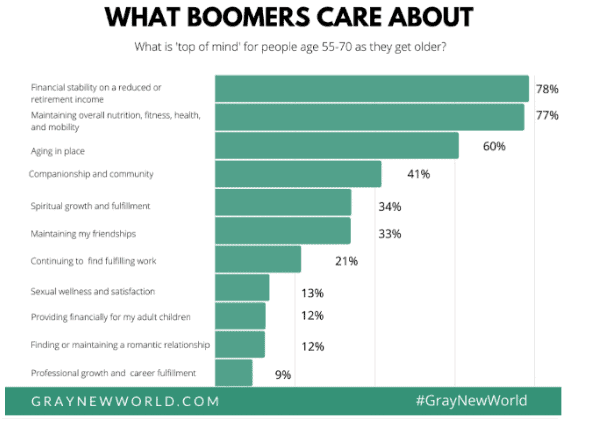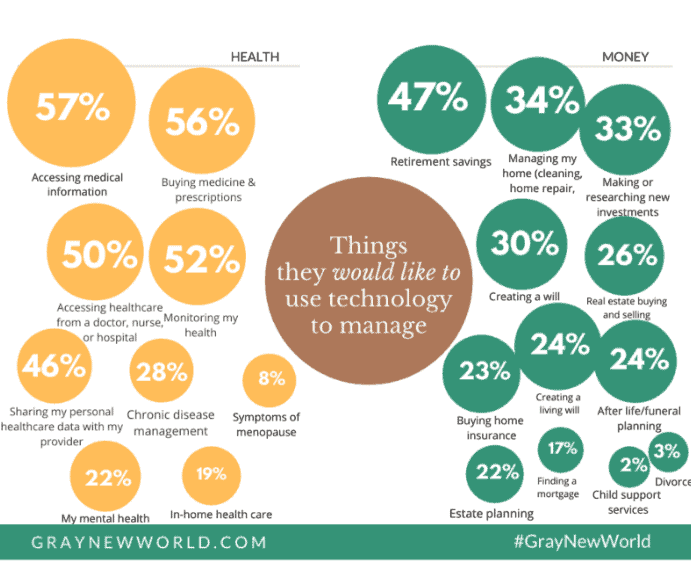Despite being the most affluent generation, Baby Boomers have become “an invisible market.” Largely ignored by tech companies, Boomers represent an untapped and underserved population in need of technological solutions that are innovated with their needs in mind.
Yet, despite this growing need, tech companies are actively innovating for the younger generation, convinced that the aging population is tech-aversive and prefers out-dated solutions.
The reality is that older generations are just as reliant on technology as everyone else. Technological innovation doesn’t cater to baby boomers’ technological needs or preferences, but that doesn’t mean those needs aren’t there.
The 2020 Aging Report, Aging in a Time of Technology by Monique Woodard reveals that tech companies have an incredible opportunity to transform the Boomer experience by designing software that’ll enable the aging population to solve pressing problems. They could even revolutionize entire industries such as retirement, healthcare, and assisted living.
Looking specifically at the aging population’s technological needs and preferences, here’s what the report found.
Baby Boomers and Marketing
Baby Boomers were born between 1946 and 1964, and they’re between 55 and 74 years old. They hold 57% of the nation’s wealth, and despite common misconceptions, they still lead an active lifestyle. And they’re also turning to technology to manage their top-of-mind concerns.
As a generation who experienced the birth of branding, Baby Boomers are accustomed to highly personalized marketing that’s aimed directly at them, and still prefer to buy products that showcase their identity and reflect their values. So while their needs may have changed, their desires haven’t.
When it comes to reaching an older audience, brands need to think beyond social media and digital marketing. While Boomers frequently shop online, they’ll often discover you in stores, or find you in some other offline medium and then make a purchase online.
The report found that Boomers are active on social media, but they should also be marketed to through traditional media channels, such as television, radio, and direct mail. Reaching older generations through these channels is well worth the effort. Boomers also spend more money shopping online than any other generation, including millennials.
Distilling The Baby Boomer Myth
There’s a common stereotype that Baby Boomers are technologically handicapped and close-minded. However, they’re neither oblivious, nor opposed to cutting-edge solutions and technological advances, such as AI programs that can increase their mobility, or biotech advancements that could potentially extend their lifespan.
While Baby Boomers didn’t grow up with Google at their fingertips, the internet has affected their lives just as dramatically as younger generations.
In fact, Boomers are active social media users, and spend an average of 27 hours online per week. 39% of Baby Boomers consider themselves to be early adopters of new technology, and the likelihood that Baby Boomers own and use a smartphone has increased 2.5x over the past 8 years.
While younger generations are more likely to adopt new technology for the sake of novelty, Baby Boomers have the resources to spend more on new software and apps. It may be that younger generations are the drivers of early technology adoption, but Boomers have the reserves to popularize those innovations.
How Baby Boomers Are Spending Their Money
While Baby Boomers were recently exceeded by millennials as the largest generation, they’re still the wealthiest—holding $3.2 trillion in direct spending power.
Boomers want to invest money in their health, financial prosperity, and memorable experiences. Primarily spending money on their homes, health care, debt, and leisurely travel, Boomers are prime candidates for technology that can target these industries.

Not only is their spending experience-driven—it’s product and technology-driven, with Baby Boomers spending 7.8 billion dollars shopping online every year.
Up & Coming Technology For Baby Boomers
Products that drive convenience have always been on trend, but it’s important to understand what specific technological trends will shape future consumer behavior and spending habits for Boomers.
Tech companies that choose to take advantage of these rising opportunities will emerge as the market winners of the aging population.
Voice Assisted Technology
66% of Baby Boomers already use voice assisted technology, such as Amazon’s Alexa, or Google Home. They’ll become increasingly reliant on voice-assisted technology as they age, and they’ll look to tech companies for ever-increasing ease of use and convenience, as voice commands enable them to eliminate tasks, reduce stress, and increase independence.
Health & Wellness Technology
When Baby Boomers were asked to identify their most pressing concerns, 78% expressed concerns relating to finance and retirement, while 77% conveyed concern about managing health and fitness.
To manage these concerns, Baby Boomers are already using technology. Yet, the survey revealed a wide margin of opportunity for tech companies to innovate around wealth and health management solutions.

According to the survey, Baby Boomers want technology to help them manage the following:
- Accessing medical information
- Buying medicine and prescriptions
- Monitoring their health
- Accessing their healthcare from a doctor, nurse, or hospital
- Retirement savings
Retirement Ready Technology
As people look to retire, they have to consider living on a reduced budget, as well as potential assisted living expenses, and estate planning. Tech-enabled platforms can help them manage these concerns, plan accordingly, and avoid high legal fees.
Rather than paying a lawyer, they can manage their estate planning online. Retirement-ready technology enables Baby Boomers to plan accordingly, closing the gap between what they’ve saved and what they’ll still need for retirement.
Technology that enables Baby Boomers to manage home buying and financing online can transform the retirement experience and help facilitate an enhanced lifestyle.
Homesharing Technology
By the time Boomers have reached retirement age, most have either paid off their house completely, or they hold considerable equity on it. Given the option, 79% of Baby Boomers said they plan to ‘age in place’, rather than moving to a retirement home.
However, aging in place can present considerable problems for Boomers if their house isn’t designed for decreased mobility and needs to be remodeled. As a result, home sharing among Boomers is on the rise.
Tech companies have already jumped on this opportunity by creating software that matches seniors to homes, such as SilverNest. Built for Boomers and empty nesters, SilverNest matches seniors to homes based on compatibility, and also provides relationship and lease management tools.
Family Driven Care Technology
The aging generations are often cared for by family members. Yet, those family members are often caught between caring for their parents and their own children.
This is an area where technology can really help. Software can enable families to manage and track care across the board, so multiple family members can track doctors appointments, symptoms, and other critical information.
Health-oriented Technology
77% of Baby Boomers identified maintaining proper health as their number two concern heading into older age. Many Boomers grew up in an era of exploding information and health movements, including the popularization of meditation. They’re a very health-conscious group, with 72% of Boomers checking labels to ensure a product is healthy.
As they age they’ll need help with general wellness, disease management, and other age-related developments. Boomers will increasingly turn to technology to address and manage these concerns. With such a large portion of the Boomer population planning to age in place, they’ll need quick and convenient access to medical products, medical care, and health management, such as menopause care.
They’ll also be looking for seamless processes that allow them to skip unnecessary and confusing steps. Several tech companies are already tapping into these needs by delivering direct-to-consumer medical products that can be easily ordered online and drive down costs by cutting out the middleman.
The Aging Reality
Today, Baby Boomers are aging, and tomorrow, Gen X, and so on. Eventually, every generation will become an aging population, and they’ll be expecting technology-enabled solutions to their growing age-related needs. By innovating for the older generation now, tech companies can set themselves up for long-term success, as well as a consistent and thriving customer base.







